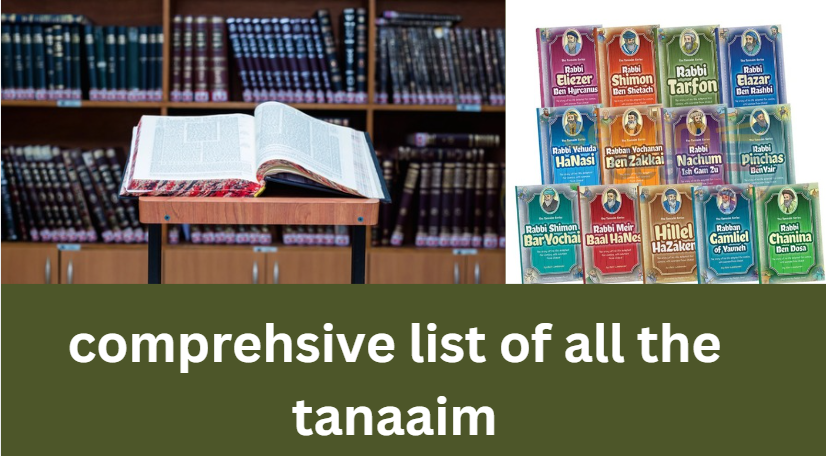The Tanaaim, or Tannaim, were influential Jewish scholars and rabbis whose teachings laid the foundations of early Rabbinic Judaism. Active between approximately 10 CE and 220 CE, their interpretations, debates, and rulings helped shape the Mishnah, a central text in Jewish religious law. This article will present a comprehensive list of all the tanaaim, offering context about their lives, teachings, and impact on Jewish scholarship, as well as addressing the significance of the Tanaaim within Jewish history.
Contents
Understanding the Role of the Tanaaim

The word “Tanna” (singular for Tanaaim) originates from the Aramaic word “Tanna,” meaning “teacher” or “repeater.” These scholars played a crucial role in orally transmitting Jewish teachings, preserving, interpreting, and codifying the Oral Torah, which complemented the Written Torah, or Hebrew Bible. Their period ended with the compilation of the Mishnah, which served as a foundation for the Talmud.
Principal Contributions of the Tanaaim
- Preservation of Oral Law: The Tanaaim were instrumental in preserving and transmitting the Oral Torah, ensuring that interpretations of the Torah could adapt to contemporary circumstances.
- Codification in the Mishnah: Compiled by Rabbi Judah ha-Nasi around 200 CE, the Mishnah is a collection of teachings and debates among the Tanaaim that forms the basis for later rabbinic discussions in the Talmud.
- Establishment of Rabbinic Judaism: The work of the Tanaaim laid the groundwork for what is now Rabbinic Judaism, influencing religious law, ethics, and customs for centuries.
Comprehensive List of All the Tanaaim and Their Impact
Below is a detailed list of the major Tanaaim, including their contributions, notable works, and impact on Jewish scholarship.
1. Rabbi Tarfon (Ṭarfon)
Era: First century CE
Notable Contributions: Rabbi Tarfon was known for his compassionate approach to halachic (Jewish legal) rulings and his emphasis on action. He was a respected figure during the destruction of the Second Temple and was one of the last of the scholars to have served in the Temple.
Teachings: Rabbi Tarfon believed that study was important, but action was paramount. His famous statement, “It is not your responsibility to complete the work, but neither are you free to desist from it,” highlights his pragmatic approach to religious observance.
2. Rabbi Ishmael ben Elisha
Era: 90–135 CE
Notable Contributions: Rabbi Ishmael was a contemporary of Rabbi Akiva and a central figure in the development of Jewish legal methodology. He is known for the “13 Rules of Rabbi Ishmael,” which serve as a foundation for interpreting the Torah.
Teachings: Rabbi Ishmael’s approach emphasized logic and clarity. He advocated for a literal and straightforward interpretation of the Torah, contrasting with the more interpretive approach of Rabbi Akiva.
3. Rabbi Akiva ben Yosef (Akiva)
Era: 40–135 CE
Notable Contributions: One of the most well-known Tanaaim, Rabbi Akiva’s contributions to Jewish scholarship were immense. He developed new methods of interpretation and was a key supporter of Bar Kokhba, leading to his martyrdom under the Romans.
Teachings: Rabbi Akiva’s teachings focused on understanding the deeper, hidden meanings of the Torah. His famous statement, “Love your neighbor as yourself,” embodies his approach to both ethics and religious observance.
4. Rabbi Johanan ben Nuri
Era: Late first to early second century CE
Notable Contributions: Rabbi Johanan ben Nuri was influential in Jewish dietary laws, particularly regarding food purity and cleanliness. His insights have influenced the observance of kosher laws.
Teachings: Known for his prudence and caution, Rabbi Johanan emphasized clarity and practical application of halacha, focusing on purity laws and ethical teachings.
5. Rabbi Jose ha-Gelili
Era: First to second century CE
Notable Contributions: Rabbi Jose ha-Gelili was a master of biblical interpretation and is recognized for his detailed teachings on sacrificial law and ritual.
Teachings: He held a compassionate view toward religious observance, prioritizing communal welfare and ensuring religious practices were accessible to all.
6. Rabbi Simeon ben Nanos
Era: First to second century CE
Notable Contributions: A lesser-known Tanna, Rabbi Simeon ben Nanos contributed to legal discussions on marriage, family law, and community life.
Teachings: His rulings generally reflect a conservative approach, emphasizing tradition and upholding established norms within the Jewish community.
7. Rabbi Judah ben Baba
Era: Second century CE
Notable Contributions: Rabbi Judah ben Baba is remembered as a martyr for his role in ordaining young scholars at a time when the Roman Empire had forbidden the practice. He played a vital role in preserving Jewish scholarship under persecution.
Teachings: Known for his courage and sacrifice, Rabbi Judah’s teachings focused on resilience and perseverance, inspiring future generations of scholars.
8. Rabbi Johanan ben Baroka
Era: First to second century CE
Notable Contributions: Rabbi Johanan ben Baroka was known for his teachings on ethics and moral behavior. He was respected for his character and dedication to Jewish law.
Teachings: He advocated a balanced approach, focusing on both the importance of studying Torah and applying its teachings in everyday life.
The Generations of Tanaaim: Tracing the Legacy

The Tanaaim are often categorized into five generations, reflecting shifts in their teachings, political environments, and external challenges, particularly under Roman rule. Here’s an outline of these generations:
First Generation Tanaaim (10–80 CE)
This generation included notable figures like Shammai and Hillel the Elder, who established different schools of thought within Jewish law. Hillel’s approach was compassionate, whereas Shammai’s was often more stringent.
Second Generation Tanaaim (80–120 CE)
This generation, marked by the destruction of the Second Temple, included figures like Rabbi Tarfon and Rabbi Ishmael. They focused on preserving Jewish law and adapting practices to a world without a central temple.
Third Generation Tanaaim (120–140 CE)
This generation saw the rise of influential scholars like Rabbi Akiva, who helped develop methods of biblical interpretation. Their work laid the foundation for future rabbinic texts and methods.
Fourth Generation Tanaaim (140–170 CE)
The scholars of this generation, including Rabbi Meir and Rabbi Shimon bar Yochai, were influential in consolidating Jewish law amidst increasing Roman oppression.
Fifth Generation Tanaaim (170–220 CE)
The fifth and final generation of Tanaaim, led by Rabbi Judah ha-Nasi, completed the Mishnah, which became the foundation for the later development of the Talmud.
Influence of the Tanaaim on Jewish Texts and Traditions

The teachings of the Tanaaim are preserved in three primary texts:
- The Mishnah: Organized by Rabbi Judah ha-Nasi, this text is a compilation of teachings and discussions among the Tanaaim. It covers various aspects of Jewish life, from religious law to civil matters.
- The Tosefta: The Tosefta is a supplementary collection of teachings, often attributed to the same Tanaaim. It includes additional explanations and discussions that complement the Mishnah.
- The Midrash: The Midrash contains interpretive teachings on the Torah. Many Tanaaim contributed to the Midrash, offering insights into the narratives and commandments found in the Torah.
FAQs on the Tanaaim
1. What does “Tanna” mean?
“Tanna” comes from Aramaic, meaning “teacher” or “repeater.” Tanaaim were rabbis who preserved and taught the Oral Torah in ancient Judaism.
2. Why were the Tanaaim important in Judaism?
The Tanaaim established the foundations of Rabbinic Judaism, creating texts like the Mishnah that later became essential to Jewish law and tradition.
3. How did the Tanaaim influence modern Judaism?
The Tanaaim’s teachings formed the core of the Talmud, influencing Jewish legal practices, ethics, and theology in ways that continue to shape Judaism today.
4. Are there still Tanaaim today?
The Tanaaim period ended with the completion of the Mishnah around 220 CE. While there are no Tanaaim today, their teachings remain integral to Jewish study and practice.
5. How does the work of the Tanaaim compare to that of the Amoraim?
The Tanaaim created and codified the Mishnah, while the Amoraim, the rabbis who came after them, expanded on the Mishnah’s teachings in the Gemara, together forming the Talmud.
Conclusion
The comprehensive list of all the tanaaim shows the depth of Jewish scholarship and the dedication of these sages to preserving and developing Jewish law and tradition. Their contributions went beyond religious rulings, shaping the identity, ethics, and resilience of Jewish communities for generations. From Rabbi Akiva’s interpretive approach to Rabbi Ishmael’s logical methods, the teachings of the Tanaaim offer timeless insights that continue to resonate within Jewish scholarship and daily life.
Related Posts Like List of All the Tanaaim
OrannaLaura: The Comprehensive Guide to a Next-Gen E-Commerce and Content Creation Platform
Onomichi Dango Masayoshi Ramen Original: A Unique Fusion of Japanese Flavors





















+ There are no comments
Add yours